
Station Name: YARMOUTH SOUTH TOWN[Source:
Darren Kitson]
Yarmouth South Town Gallery 7: 1969 - 1976 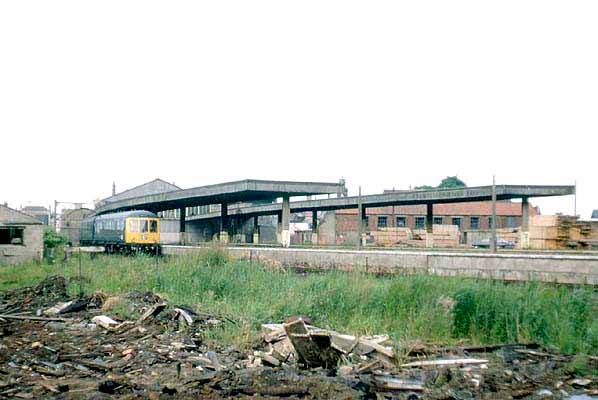
South Town station in 1969, the last full year of services. Most redundant track had been lifted the previous year and the Lowestoft DMU service shifted to Platform 4 as seen here. By 1969 the 79xxx series DMUs had mostly been withdrawn and Blue Square units appeared more often before taking over entirely for the last year or so. The unit seen here is headed by a freshly repainted Class 108 driving trailer coupled to what appears to be a Metro-Cammell Class 101 driving motor. In the left background the rarely photographed goods loading gauge can be seen. A bufferstop can be seen peering out of the weeds. The camera angle is deceiving; the bufferstop was at the end of a relatively short siding while the loading gauge was on an adjacent road which continued to the maltings. Whether in 1969 the bufferstop stood isolated or the siding was still in situ is not known. It was probably still in situ but disconnected for at this time, but not visible here, a few isolated sets of points and crossings remained scattered around the site. The hut on the left may have contained a weighbridge at one time but this detail remained a mystery at the time of writing. In the right background a timber merchant has taken over the coal wharf site and the site of the tracks which led to the goods yard, these passed through a gap between the station building and the warehouse seen in the right background. At this time the embedded tracks on the south side of the station forecourt remained in situ and would continue to do so until the site was cleared in 1978.
Photo by Bevan Price 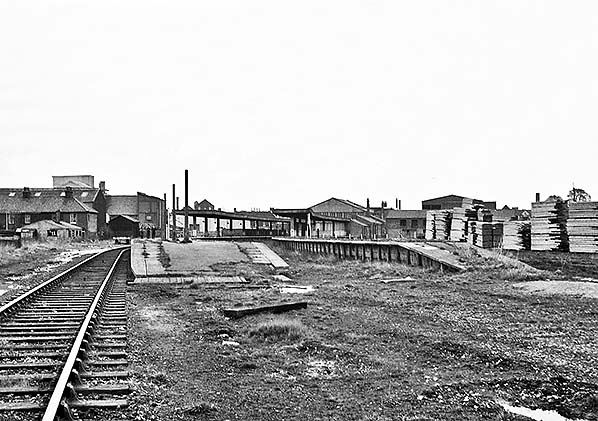 The three-quarters derelict South Town station in the 1968 - 70 period. The three people on Platform 4 might suggest a visit by a group of enthusiasts: a common occurrence in the period leading up to railway closures.
Photo from John Mann collection 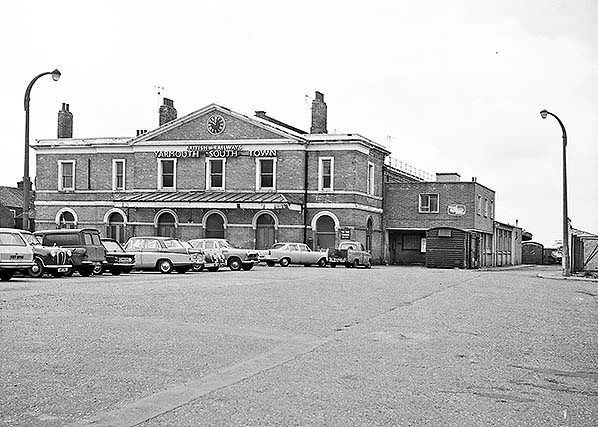
South Town station seen here during the final couple of years of the train service as the 'To The Trains' sign is still present. Two grounded van bodies can be seen; that seen through the gap on the right is on the section of platform behind the buffers of Platform 4 and outside the low concrete wall. The sign on the wall above the nearest van body is duplicated on the right, visible in front of the loading gauge. The sign appears in a number of photographs but is readable on none. The logo, however, is discernible enough to show it represents a rig so will be connected with the offshore drilling industry. This photograph was obviously taken on the same day as others of the forecourt as the haphazardly parked Ford Zephyr, or Zodiac, MkIII and pickup are visible, albeit partly hidden, in another view. The pickup appears to be an Austin A55, officially the Austin HK6. Other vehicles are, from left and with registration numbers given when readable; Ford Escort MkII estate reg. no. VRT 891G; Austin A35 van reg. no. 685 DBJ; Ford Thames van, either a 307E or 309E and based upon the Anglia saloon; Hillman Imp reg. no. SPW 387G; Riley 4/72; Jaguar Mark 2; Austin A55 Cambridge Mark II. Of these, the Escort MkII and Austin A35 both have Lowestoft registration numbers (RT and BJ). The A35 has flashing indicators yet appears to be carrying an A30 grille, but its registration number was issued in October 1959 which tells us it is an A35. The Hillman Imp has a Norfolk (County) registration issued in November 1968. The Imp and its Singer and Sunbeam sisters were among the very few British-built cars to have a rear engine; a Rootes adaption of a Coventry Climax fire pump engine which had enjoyed some racing success. The engine was all-aluminium and there was a tendency to fill the cabin with unpleasant fumes. There were other issues with the car, of reliability and less-than-ideal production arrangements, which are said to have led to the takeover of Rootes Group by Chrysler Europe in 1967.
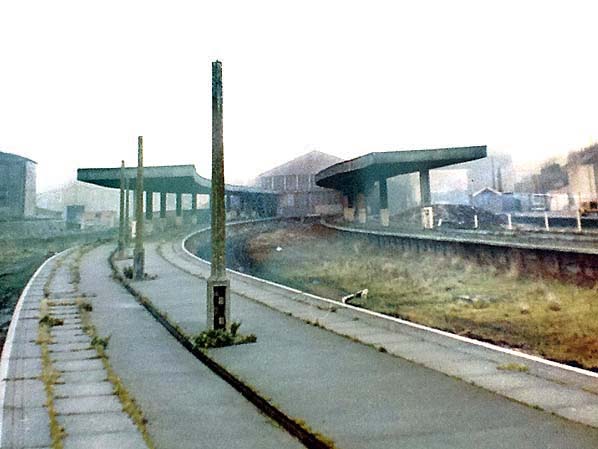
South Town station during 1970 shortly after closure. In its final years the DMU service to Lowestoft had used Platform 4, left, and the track has been lifted. The former arrivals platform, Platform 3, second from left, appears to still have track in situ but on close scrutiny it is merely the dirty, oily imprint left in the ballast. The grassy, weed-infested area between the islands marks the site of other tracks which had been lifted in 1968 following several years of disuse. Still standing are some of the concrete standards installed in 1952 which once bore fluorescent lights bearing the station name. In the right background can be seen part of the former coal wharf with its pitched roof office. There would have been a weighbridge but surviving company records make no mention of such. A weighing machine is mentioned but this was a different instrument to a weighbridge and used for parcels and sundries.
Photo by Michael Sayer 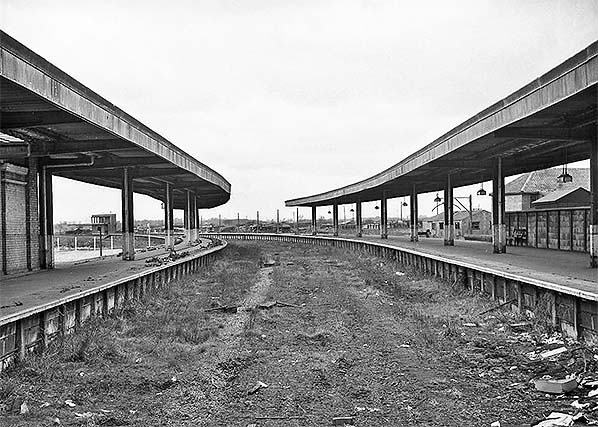 An undated view of South Town station with the station building immediately behind the camera and probably taken just before closure. The derelict shell of the signal box can be seen in the left background. Beneath the canopy, right, lamps still hang and a bench is placed against the wall. It is a wooden bench and had possibly come from inside the station building or perhaps the waiting rooms on the disused Platforms 1 and 2, left. The loading gauge is still present as is the bufferstop
against the dock. Photo from John Mann collection 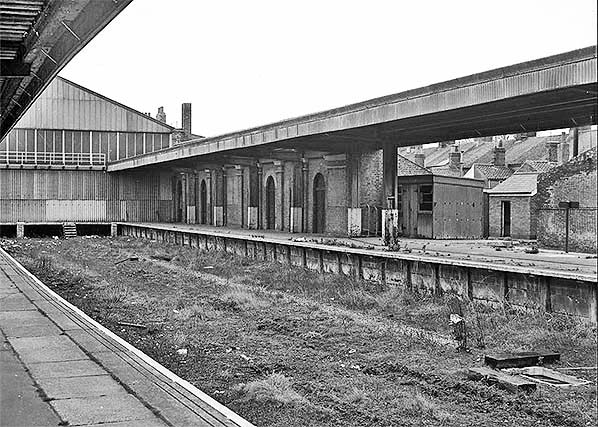 There are countless photographs of South Town station when moribund or closed in existence but few show anything of particular interest. This one, however, is useful as it gives a fairly uncluttered view of the various rooms on the former Up platform. Once supporting the trainshed roof, this row of rooms extended right back to main part of the station building. Thought to have originally been a combine of waiting rooms, toilets and staff rooms, over the decades they came to be used for a number of purposes and the following description is based on known purposes after 1952. Starting nearest the camera, the first doorway was the lamp room, No.1 room. The next doorway was a coal store, No.2 room, and its floor was at ground, rather than platform, level thus there was a flight of steps down from the door. Prior to 1952 there was no doorway from the platform; the 1952 doorway is largely hidden behind the second awning stanchion in this view and been transferred from further along where the blank section of wall can be seen. It was a square-topped doorway, lacking an arch. The next room, No.3, was a storeroom and it was linked to No.2 room internally. Its floor was also at ground level and thus also had steps leading down from the external doorway. The BR plan from 1952 marked the external doorway as to be bricked up and the steps to be removed but clearly this change did not occur. It was another archless doorway and is also obscured by a stanchion in this view. Moving along, No.4 room was a porters and shunters messroom fitted with lockers, wardrobe, gas cooker and sink unit. Next came No.5 room, for female staff. No.6 room, the doorway for which is obscured, was a guards’ room. At the very end was No.7 room, a small almost cupboard-like room for inspectors. Room Nos.8 and onwards were on the concourse and are described with the relevant pictures. Of the rooms mentioned in this caption only No.1, the lamp room, survived the 1952 alterations with no changes. Rooms 6 and 7 were created from what had been three separate rooms, thought to have originally been waiting rooms.* The guards’ room, by far the larger of Rooms 6 and 7, was formed by the removal of the dividing wall. A new dividing wall was constructed further along to create the inspectors room. There was a total of seven doorways and one window facing onto Platform 2. At the rear, overlooking the goods yard roads, were a total of nine arched windows plus, at the rear of the coal room, what appears to have been a door or hatch for the delivery of coal. Mention has been made of doorways being transferred from elsewhere. In the 1952 alterations this meant that doors, wooden framework etc. were literally removed and reinstalled elsewhere but plans made it clear that where a former doorway or window was to be bricked-up, the Reveal was to remain. This was done for the purpose of visual symmetry, or at least a degree of, but at South Town applied only to rooms facing onto the concourse and this is why the bricked-up doorway seen in this view was removed entirely (the 'footprint' on the wall, suggestive of a bricked-up window, was in fact left behind when poster boards were removed). A 'Reveal' is a basic framework remaining after a feature has been removed, or built-in where a feature might be required in the future - rather like a picture frame with no picture in it. It was and to a lesser degree still is a quite common architectural practice but one which can cause confusion in historical studies. [* Waiting rooms are marked as such on the 1909 fire insurance plan reproduced elsewhere but the partial station building plan is by no means well detailed].. There are countless photographs of South Town station when moribund or closed in existence but few show anything of particular interest. This one, however, is useful as it gives a fairly uncluttered view of the various rooms on the former Up platform. Once supporting the trainshed roof, this row of rooms extended right back to main part of the station building. Thought to have originally been a combine of waiting rooms, toilets and staff rooms, over the decades they came to be used for a number of purposes and the following description is based on known purposes after 1952. Starting nearest the camera, the first doorway was the lamp room, No.1 room. The next doorway was a coal store, No.2 room, and its floor was at ground, rather than platform, level thus there was a flight of steps down from the door. Prior to 1952 there was no doorway from the platform; the 1952 doorway is largely hidden behind the second awning stanchion in this view and been transferred from further along where the blank section of wall can be seen. It was a square-topped doorway, lacking an arch. The next room, No.3, was a storeroom and it was linked to No.2 room internally. Its floor was also at ground level and thus also had steps leading down from the external doorway. The BR plan from 1952 marked the external doorway as to be bricked up and the steps to be removed but clearly this change did not occur. It was another archless doorway and is also obscured by a stanchion in this view. Moving along, No.4 room was a porters and shunters messroom fitted with lockers, wardrobe, gas cooker and sink unit. Next came No.5 room, for female staff. No.6 room, the doorway for which is obscured, was a guards’ room. At the very end was No.7 room, a small almost cupboard-like room for inspectors. Room Nos.8 and onwards were on the concourse and are described with the relevant pictures. Of the rooms mentioned in this caption only No.1, the lamp room, survived the 1952 alterations with no changes. Rooms 6 and 7 were created from what had been three separate rooms, thought to have originally been waiting rooms.* The guards’ room, by far the larger of Rooms 6 and 7, was formed by the removal of the dividing wall. A new dividing wall was constructed further along to create the inspectors room. There was a total of seven doorways and one window facing onto Platform 2. At the rear, overlooking the goods yard roads, were a total of nine arched windows plus, at the rear of the coal room, what appears to have been a door or hatch for the delivery of coal. Mention has been made of doorways being transferred from elsewhere. In the 1952 alterations this meant that doors, wooden framework etc. were literally removed and reinstalled elsewhere but plans made it clear that where a former doorway or window was to be bricked-up, the Reveal was to remain. This was done for the purpose of visual symmetry, or at least a degree of, but at South Town applied only to rooms facing onto the concourse and this is why the bricked-up doorway seen in this view was removed entirely (the 'footprint' on the wall, suggestive of a bricked-up window, was in fact left behind when poster boards were removed). A 'Reveal' is a basic framework remaining after a feature has been removed, or built-in where a feature might be required in the future - rather like a picture frame with no picture in it. It was and to a lesser degree still is a quite common architectural practice but one which can cause confusion in historical studies. [* Waiting rooms are marked as such on the 1909 fire insurance plan reproduced elsewhere but the partial station building plan is by no means well detailed]..Photo from John Mann collection 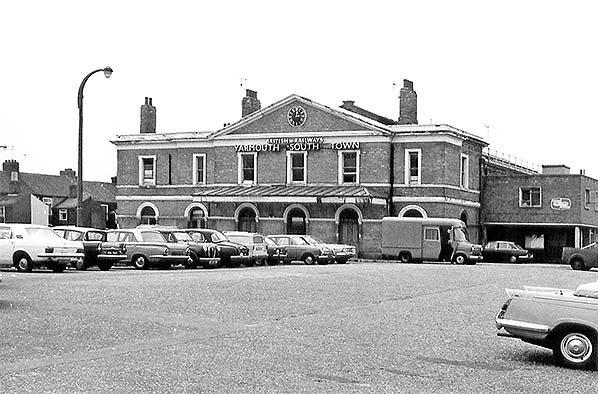
An undated view of South Town station building and forecourt, probably taken just before closure. The one date clue is unfortunately hidden by the Ford Transit; a 'To The Trains' sign which if present would have given the answer. Once again we have an interesting line-up of road vehicles. From left, Ford Zephyr 6 MkIV, Ford Anglia 105E, Ford Cortina MkI, Austin A30 van, Rover P4 (one of the pre-1954 models with smaller boot), Reliant Regal van, unidentified but possibly a Renault 8, Ford Zodiac MkIV and perhaps the Executive variant. The previously mentioned Ford Transit is a Mark 1 version, petrol engined. The diesel version had a different grille with rather pronounced 'snout'. The Transit is still in production today albeit now vastly different to its ancestors. Behind the Transit is a Triumph, either a 2000 or 2500. The pickup, right background, is unidentified. In the right foreground is a Triumph Herald convertible. It has the 'crossed flags' emblem on its rear wings, found on the 948, 1200
and 12/50 models. Photo from John Mann collection 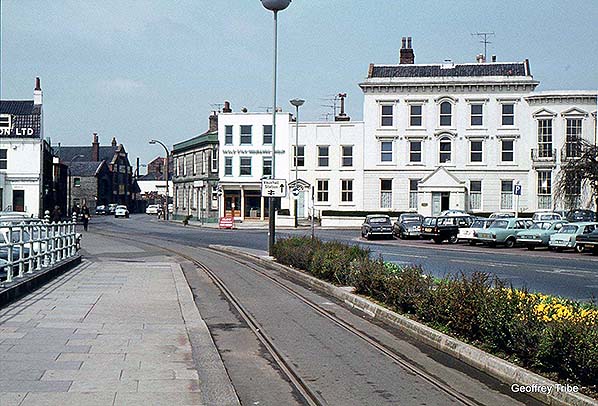
Whilst not directly relevant to South Town station, this view from 2 May 1970 showing part of the quayside tramway is worth including as the date was significant in the history of Yarmouth's railways. The camera is on Hall Quay and looking towards North Quay and, as the sign informs us, Vauxhall station. A few yards behind the camera is Haven Bridge, opposite which and on the other side of the Yare stood South Town station. 2 May was the final day of services on the Lowestoft - Yarmouth line. Behind the camera, the quayside tramway continued for some distance along the east bank of the Yare to the Fish Wharf. Ahead of the camera things were rather more complicated. Just out of sight around the bend, left background, a short spur left the tramway to serve sidings just north of Fishers Quay. These sidings were at a right angle to the Yare and accessed via a very sharp curve. Some 200 yards further on the tramway left the street to cross the Bure, which flows into the Yare nearby, via Vauxhall Bridge and thereafter connect into sidings on the east side of Vauxhall station.
Click here for a much more detailed caption and click here for a picture of a Drewry Class 04 diesel shunter complete with side skirts and cowcatchers at Yarmouth Vauxhall. These used to operate on the quayside tramway. Photo by Geoffrey Tribe 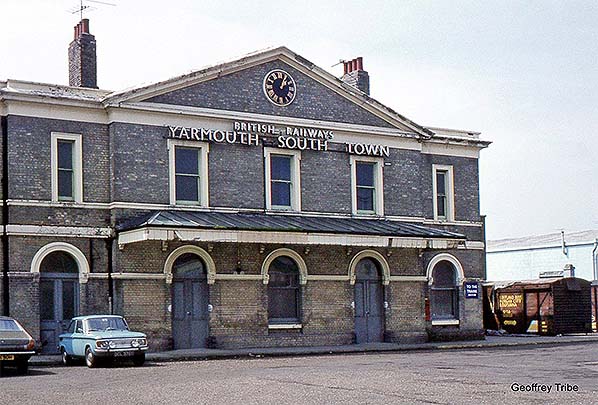 Another view of South Town station building from the forecourt but this time in colour. Within hours of this photograph being taken the 'To The Trains' sign on the right would no longer apply for this was the final day of the Lowestoft - Yarmouth services, Saturday 2 May 1970. This dismal sight, with intending passengers being shuffled around the side of this once main line station to what had been Platform 4, was not untypical of British Rail during the 1960s and 1970s and did nothing to discourage people from abandoning the railways and buying cars. Nevertheless, the Lowestoft - Yarmouth train service remained quite well used until the end and this was partly due to the 1953 closure of the Breydon link over which many Lowestoft trains had run to and from Beach station. Monday 4 May 1970, official closure day, would have been the start of BR's summer timetable for the line and indeed this timetable was actually published. Presumably this was an error committed in some far away BR office but it could have been deliberate as a mischievous act of protest. We will probably never know. The grounded van body on the right, still bearing its BR 'Cond' (meaning Condemned, ie withdrawn) inscription bears the bold inscription 'Loffland Bros Morgan City Louisiana USA'. Loffland Brothers Drilling was an old established oil exploration company and once the largest such outfit in the world. They were taken over by Nabors Industries in 1990. Nabors are headquartered in Hamilton, Bermuda, but have operations in Houston, Texas; Anchorage, Alaska; as well as in Canada and the UAE. The car facing the camera is an NSU; this same vehicle is seen in, and described with, another image. To its left is a Hillman Avenger and it bears an 'H' registration so was virtually brand new when this photograph was taken. Launched in February 1970, the Avenger for some reason became the butt of jokes although by the standards of British cars of the day there was little about them to find fault with.
Photo by Geoffrey Tribe
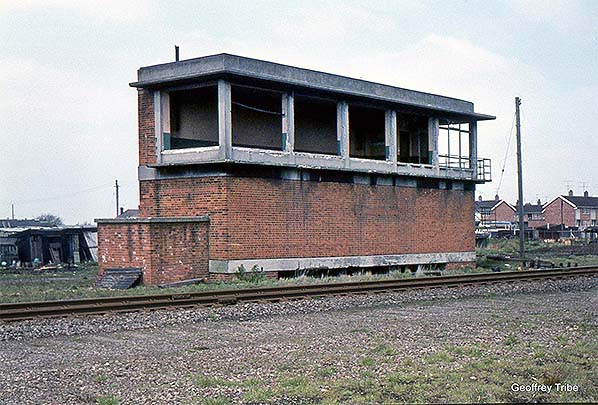 The sorry sight that was the shell of Yarmouth South Town signal box as it towered over the remaining single track on 2 May 1970, the final day of services to South Town. In the right background some typical-of-the-time houses and flats have appeared. Those parallel to the railway are on High Mill Road while the others are on Coronation Green and Coronation Road. They stand on land once owned by the barrel factory, located on Marsh Road, and which was a user of the railway but was not rail connected. The houses and flats still stand today but this view is no longer possible due to industrial units having been built along Pasteur Way which itself runs through the site of the signal box. This box, which was an ARP design dating from 1943, is described elsewhere.
Photo by Geoffrey Tribe Click here for Yarmouth South Town Gallery 8:
 Home Page Home Page
|
